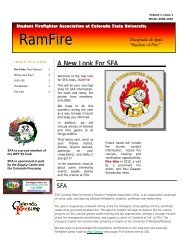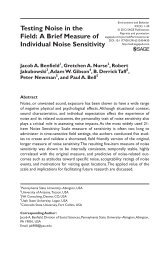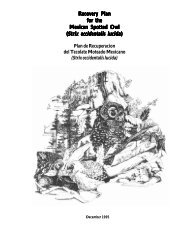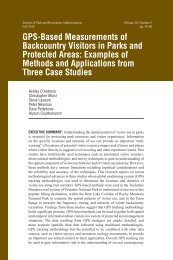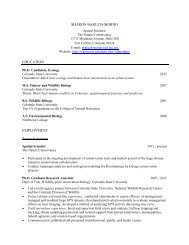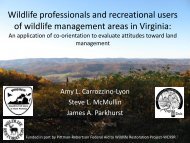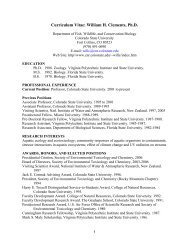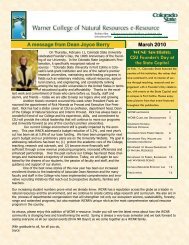Comparing a Convenience Sample against a Random Sample of ...
Comparing a Convenience Sample against a Random Sample of ...
Comparing a Convenience Sample against a Random Sample of ...
Create successful ePaper yourself
Turn your PDF publications into a flip-book with our unique Google optimized e-Paper software.
<strong>Comparing</strong> a <strong>Convenience</strong> <strong>Sample</strong><br />
Against a <strong>Random</strong> <strong>Sample</strong> <strong>of</strong> Duck<br />
Hunters 1<br />
Mark G. Alessi<br />
Craig A. Miller<br />
Human Dimensions Research Program<br />
Illinois Natural History Survey<br />
Prairie Research Institute<br />
University <strong>of</strong> Illinois<br />
1 Alessi, M.G., and C.A. Miller. 2012. <strong>Comparing</strong> a <strong>Convenience</strong> <strong>Sample</strong> Against a <strong>Random</strong><br />
<strong>Sample</strong> <strong>of</strong> Duck Hunters. Human Dimensions <strong>of</strong> Wildlife, 17, 155-158
• Rich duck hunting<br />
tradition & bounty in<br />
Illinois<br />
– 1901: 4 Illinois<br />
hunters harvest ~850<br />
ducks in 1 day<br />
– 1902: First duck limits<br />
were established in<br />
U.S.<br />
Introduction<br />
Photo by Josh Stafford
Introduction<br />
• 1865: 1 statewide duck zone established<br />
• 1977: 2 duck zones established<br />
• 1980: 3 duck zones established<br />
• 1991: USFWS implement 5-year plans<br />
• 2011: 4 th duck zone option recommended to<br />
USFWS by Illinois Department <strong>of</strong> Natural<br />
Resources (IDNR)
• IDNR managers<br />
typically receive<br />
feedback by:<br />
– Phone calls<br />
– E-mails<br />
– Illinois Waterfowl<br />
Hunter Survey<br />
(I.W.H.S.)<br />
– Public meetings<br />
Introduction<br />
Bubba<br />
State waterfowl<br />
biologist
Introduction<br />
• Attendees to public meetings may not<br />
represent the general population<br />
– Attendance to meetings will be influenced by<br />
• # <strong>of</strong> mallards harvested<br />
• # <strong>of</strong> days hunted<br />
• # <strong>of</strong> counties hunted<br />
• # <strong>of</strong> years hunting
Methods-<strong>Random</strong> Survey<br />
• Illinois Waterfowl Hunter Survey (I.W.H.S.)<br />
– Administered annually since 1981<br />
– Mail survey to 5,000 stamp purchasers<br />
• <strong>Random</strong>ized<br />
• Recipients receive a harvest card prior to season<br />
– What’s calculated:<br />
• Participation<br />
• Harvests
Methods-Open Houses (O.H.)<br />
• IDNR hosted 5 open houses throughout Illinois<br />
in June 2011<br />
– Disseminate information to the public<br />
– Gather attendees’ opinions<br />
• Illinois Natural History Survey administers<br />
questionnaire to every attendee<br />
– Questions on:<br />
• Participation<br />
• Harvest
Open house locations
Methods<br />
• Independent variable:<br />
– O.H. attendee<br />
– I.W.H.S respondent<br />
• Dependent variables:<br />
– # <strong>of</strong> counties hunted<br />
– # <strong>of</strong> years hunting<br />
– # <strong>of</strong> days hunted<br />
– # <strong>of</strong> mallards harvested<br />
• Chi-square analyses and effect sizes
• Response rates:<br />
– I.W.H.S. – 54% (n = 2,558)<br />
– O.H. – 99% (n = 480)<br />
– 91% <strong>of</strong> O.H. returned<br />
I.W.H.S.<br />
Results
Percent<br />
60%<br />
50%<br />
40%<br />
30%<br />
20%<br />
10%<br />
0%<br />
55%<br />
Word <strong>of</strong><br />
Mouth<br />
27%<br />
Results<br />
25%<br />
19%<br />
14%<br />
E-mail IDNR Website Article Other<br />
How did you hear about the meetings?
70%<br />
60%<br />
50%<br />
40%<br />
30%<br />
20%<br />
10%<br />
0%<br />
Results- Duck Zone Boundaries<br />
37%<br />
18%<br />
7%<br />
22%<br />
56%<br />
60%<br />
Dissatisfied Unsure Satisfied<br />
Open House<br />
Mail Survey<br />
χ 2 = 136.86, p < .001, Cramer’s V = .28
60%<br />
50%<br />
40%<br />
30%<br />
20%<br />
10%<br />
0%<br />
51%<br />
Results- Season Dates<br />
34%<br />
7%<br />
15%<br />
43%<br />
51%<br />
Dissatisfied Unsure Satisfied<br />
Open House<br />
Mail Survey<br />
χ 2 = 116.50, p < .001, Cramer’s V = .26
Percent<br />
70%<br />
60%<br />
50%<br />
40%<br />
30%<br />
20%<br />
10%<br />
0%<br />
Results- Days Hunting<br />
0 1-10 11-22 >22<br />
# <strong>of</strong> Days Hunting<br />
Open House<br />
Mail Survey<br />
χ 2 = 372.94, p < .001, Cramer’s V = .44
Percent<br />
60%<br />
50%<br />
40%<br />
30%<br />
20%<br />
10%<br />
0%<br />
Results – Mallard Harvest<br />
0 1-14 15-36 > 36<br />
# <strong>of</strong> Mallards Harvested<br />
Open House<br />
Mail Survey<br />
χ 2 = 340.61, p < .001, Cramer’s V = .42
Results – Counties, Years, & Age<br />
# <strong>of</strong> counties<br />
hunted<br />
# <strong>of</strong> years<br />
hunted<br />
Age <strong>of</strong><br />
respondent<br />
Open<br />
House<br />
Mail<br />
Survey t P-value Cohen’s d<br />
= 1.6 = 1.3 5.57 p < .001 .32<br />
= 30.3 = 22.0 9.00 p < .001 .48<br />
= 47.9 = 45.9 2.46 p < .05 .13
Discussion<br />
• Open-house attendees did not represent the<br />
“average” IL duck hunter.<br />
– More experienced (Cornicelli & Grund 2011, Johnson et al.<br />
1993)<br />
– Higher harvest (Johnson et al. 1993)<br />
– More days hunting (Johnson et al. 1993)<br />
– Older hunters
• Issue salience:<br />
Discussion<br />
– 91% <strong>of</strong> attendees returned I.W.H.S.<br />
– As opposed to 54% <strong>of</strong> I.W.H.S. response rate<br />
• Attendees have significant interest in duck<br />
hunting<br />
– Attendees may be more critical than nonattendees<br />
(McComas & Scherer 1998, Johnson et al. 1993)<br />
• More dissatisfied than mail survey hunters<br />
– Undersampled stratum
Discussion<br />
• Management decision issues:<br />
– Non-representational feedback<br />
– Non-attendees have less interest<br />
• 36% will accept whatever IDNR determines<br />
– Necessary at local levels<br />
• Hunters demand a role in managing wildlife<br />
• Strengthens relationship with hunters<br />
• Supplement random data with meetings
Approved Zones and Boundaries
Acknowledgements<br />
• Illinois Natural History Survey<br />
– Linda Campbell<br />
– Molly Spacapan<br />
– Samantha Carpenter<br />
– Katie Yi<br />
– Michelle Horath<br />
• Illinois Department <strong>of</strong> Natural Resources<br />
– Ray Marshalla<br />
– Roy Domazlicky<br />
– Dan Holm<br />
– John Buhnerkempe<br />
• All participants!
This study funded by Federal Aid in Wildlife<br />
Restoration Grant W-112-R-21
Questions?<br />
Photo by Josh Stafford



